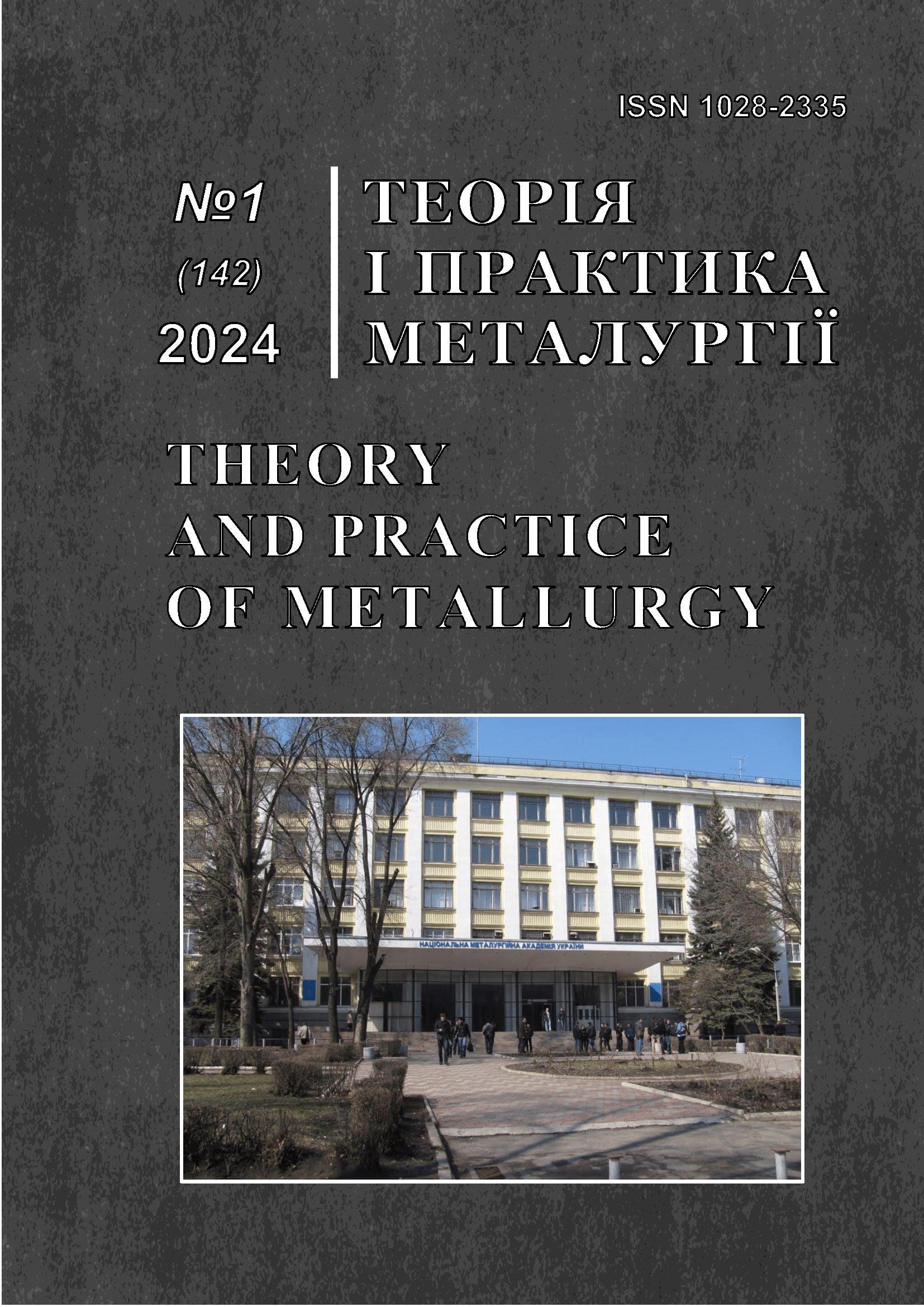Analysis of the efficiency of replacing natural gas with biomass in the iron ore pellet firing process
DOI:
https://doi.org/10.15802/tpm.1.2024.05Keywords:
iron ore pellets, firing, plant-based fuel, biomass combustion, solid fuel particle combustion rate, wheat straw, sunflower husks, wood, charcoalAbstract
Purpose. One of the most critical challenges in the metallurgical industry is reducing dependence on natural gas used in the iron ore pellet firing process. The high cost and supply instability of natural gas have a significant impact on both the economy and the environment, particularly in the context of efforts to reduce CO2 emissions and other harmful substances. Replacing natural gas with biofuels, such as lignocellulosic biomass, could provide an effective solution to decrease fossil fuel consumption and improve the environmental performance of production. The primary objective of this study is to develop and optimize a method for using biofuels in the iron ore pellet firing process, aiming to achieve the required temperature regime while maintaining high product quality and minimizing the negative environmental impact. Methodology. Theoretical and experimental justification for the replacement of natural gas with biofuels in the iron ore pellet firing process was carried out using calculation formulas from relevant literature, as well as utilizing a web application for modeling and analyzing the results. Findings. The application of biofuels to replace natural gas in the iron ore pellet firing process revealed several important aspects. The introduction of biomass particles into the gas stream allowed for the partial replacement of natural gas without significantly affecting the thermal regime of the firing machine. This is because the combustion products of biomass, as well as the stoichiometric air volume required for complete biomass combustion, have a smaller volume compared to the combustion products and stoichiometric air volume required for natural gas. This helps to offset the lower calorific value of biomass. Based on the calculations and considering real-world experience with replacing natural gas with sunflower husks, it is proposed to burn 0.2 kg of sunflower husks, 0.125 kg of wood charcoal, 0.22 kg of sawdust, and 0.25 kg of straw for every 10% of replaced natural gas volume. Additionally, the combustion time of biomass particles was calculated depending on their initial diameter. The critical factor determining the combustion time of a particle is the volatile matter content, which in turn determines the amount of the particle’s coke residue. The combustion of the coke residue is the longest stage in the overall particle combustion time. The obtained combustion rates, from the highest to the lowest, are as follows: straw, sunflower husks, wood, and wood charcoal. This indicates that straw, as the fuel with the highest combustion rate, can have the largest particle size that meets the technological requirements for use in the firing machine burner. Originality. The combustion products of biomass have a smaller volume, which compensates for its lower calorific value and minimizes the impact on the thermal regime of the firing machine. Optimal biomass ratios have been proposed for replacing every 10% of the natural gas volume, including sunflower husks, wood charcoal, sawdust, and wheat straw. Additionally, based on the calculations of the combustion time of biofuel particles, it was found that straw has the highest combustion rate, allowing for the use of larger particle sizes in the firing machine burner, thus meeting technological requirements. Practical value. The calculations carried out in this work enable the replacement of 40 to 60 vol.% of natural gas with various types of plant-based fuels. Additionally, these calculations provide the means to assess the required granulometric composition of the fuel for use in the iron ore pellet firing process.
References
Kieush, L. et al. (2021). Research paper production of iron ore pellets by utilization of sunflower husks. Acta Metallurgica Slovaca, 27(4), 167-171. https://doi.org/10.36547/ams.27.4.1052
Paraschiv, L. S., Serban, A., & Paraschiv, S. (2020). Calculation of combustion air required for burning solid fuels (coal/biomass/solid waste) and analysis of flue gas composition. Energy Reports, 6, 36-45. https://doi.org/10.1016/j.egyr.2019.10.016
Choi, S. & Kruger, C. H. (1985). Modeling coal particle behavior under simultaneous devolatilization and combustion. Combustion and Flame, 61(2), 131-144. https://doi.org/10.1016/0010-2180(85)90159-2
Toporov, D. D. (2014). Chapter 4 - Mathematical Modelling and Model Validations. In Combustion of Pulverised Coal in a Mixture of Oxygen and Recycled Flue Gas. (pp. 51-97). Elsevier. https://doi.org/10.1016/B978-0-08-099998-2.00004-7
Spliethoff, H. (2010). Combustion systems for solid fossil fuels. In Power Generation from Solid Fuels. Part of the book series: Power Systems. (pp. 221-359). Springer. https://doi.org/10.1007/978-3-642-02856-4_5
Wornat, M. J., Hurt, R. H., Davis, K. A. and Yang, N. Y. (1996). Single-particle combustion of two biomass chars. Symposium (International) on Combustion, 26(2),3075-3083. https://doi.org/10.1016/S0082-0784(96)80151-2
Li, J., Paul, M. C., Younger, P. L., Watson, I., Hossain, M. & Welch, S. (2015)."Characterization of biomass combustion at high temperatures based on an upgraded single particle model. Applied Energy, 156, 749-755.
Grotkjær, T., Dam-Johansen, K., Jensen, A. D., & Glarborg, P. (2003). An experimental study of biomass ignition. Fuel, 82(7), 825-833. https://doi.org/10.1016/S0016-2361(02)00369-1
Blott, S. J., & Pye, K. (2008). Particle shape: a review and new methods of characterization and classification. Sedimentology, 55(1), 31-63. https://doi.org/10.1111/j.1365-3091.2007.00892.x
Downloads
Published
How to Cite
Issue
Section
License
Copyright (c) 2024 Boyko M.M., Yefimenko V.V., Makhorkina T.A., Polyakova N.V., Zhuravlova S.V., Kolesnikova Т.М.

This work is licensed under a Creative Commons Attribution 4.0 International License.
Authors retain copyright of the published papers and grant to the publisher the non-exclusive right to publish the article, to be cited as its original publisher in case of reuse, and to distribute it in all forms and media. Articles will be distributed under the Creative Commons Attribution 4.0 International (CC BY 4.0) licence.
Authors can enter the separate, additional contractual arrangements for non-exclusive distribution of the published paper (e.g., post it to an institutional repository or publish it in a book), with an acknowledgement of its initial publication in this journal.




